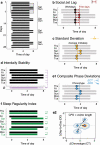Measuring sleep regularity: theoretical properties and practical usage of existing metrics
- PMID: 33864369
- PMCID: PMC8503839
- DOI: 10.1093/sleep/zsab103
Measuring sleep regularity: theoretical properties and practical usage of existing metrics
Abstract
Study objectives: Sleep regularity predicts many health-related outcomes. Currently, however, there is no systematic approach to measuring sleep regularity. Traditionally, metrics have assessed deviations in sleep patterns from an individual's average; these traditional metrics include intra-individual standard deviation (StDev), interdaily stability (IS), and social jet lag (SJL). Two metrics were recently proposed that instead measure variability between consecutive days: composite phase deviation (CPD) and sleep regularity index (SRI). Using large-scale simulations, we investigated the theoretical properties of these five metrics.
Methods: Multiple sleep-wake patterns were systematically simulated, including variability in daily sleep timing and/or duration. Average estimates and 95% confidence intervals were calculated for six scenarios that affect the measurement of sleep regularity: "scrambling" the order of days; daily vs. weekly variation; naps; awakenings; "all-nighters"; and length of study.
Results: SJL measured weekly but not daily changes. Scrambling did not affect StDev or IS, but did affect CPD and SRI; these metrics, therefore, measure sleep regularity on multi-day and day-to-day timescales, respectively. StDev and CPD did not capture sleep fragmentation. IS and SRI behaved similarly in response to naps and awakenings but differed markedly for all-nighters. StDev and IS required over a week of sleep-wake data for unbiased estimates, whereas CPD and SRI required larger sample sizes to detect group differences.
Conclusions: Deciding which sleep regularity metric is most appropriate for a given study depends on a combination of the type of data gathered, the study length and sample size, and which aspects of sleep regularity are most pertinent to the research question.
Keywords: circadian disruption; circadian misalignment; inter-individual variability; intra-individual variability; sleep stability; sleep variability.
© Sleep Research Society 2021. Published by Oxford University Press on behalf of the Sleep Research Society. All rights reserved. For permissions, please email: journals.permissions@oup.com.
Figures







Similar articles
-
An exploratory pilot study on social rhythm regularity, and its associations with sleep, circadian, affective, and alcohol use outcomes in late adolescents.J Sleep Res. 2025 Jun;34(3):e14346. doi: 10.1111/jsr.14346. Epub 2024 Sep 24. J Sleep Res. 2025. PMID: 39317647
-
Irregular sleep-wake patterns in older adults with current or remitted depression.J Affect Disord. 2021 Feb 15;281:431-437. doi: 10.1016/j.jad.2020.12.034. Epub 2020 Dec 11. J Affect Disord. 2021. PMID: 33360364
-
How many days are enough? Sleep-wake timing regularity and fragmentation scores change with the number of days included.J Sleep Res. 2025 Jun;34(3):e14332. doi: 10.1111/jsr.14332. Epub 2024 Sep 24. J Sleep Res. 2025. PMID: 39317644
-
Irregular sleep and cardiometabolic risk: Clinical evidence and mechanisms.Front Cardiovasc Med. 2023 Feb 17;10:1059257. doi: 10.3389/fcvm.2023.1059257. eCollection 2023. Front Cardiovasc Med. 2023. PMID: 36873401 Free PMC article. Review.
-
From circadian clock mechanism to sleep disorders and jet lag: Insights from a computational approach.Biochem Pharmacol. 2021 Sep;191:114482. doi: 10.1016/j.bcp.2021.114482. Epub 2021 Feb 20. Biochem Pharmacol. 2021. PMID: 33617843 Review.
Cited by
-
Night-time sleep duration and postpartum weight retention in primiparous women.Sleep Adv. 2023 Dec 27;5(1):zpad056. doi: 10.1093/sleepadvances/zpad056. eCollection 2024. Sleep Adv. 2023. PMID: 38314118 Free PMC article.
-
Associations of smartphone usage patterns with sleep and mental health symptoms in a clinical cohort receiving virtual behavioral medicine care: a retrospective study.Sleep Adv. 2023 Jul 5;4(1):zpad027. doi: 10.1093/sleepadvances/zpad027. eCollection 2023. Sleep Adv. 2023. PMID: 37485313 Free PMC article.
-
Toddler Screen Use Before Bed and Its Effect on Sleep and Attention: A Randomized Clinical Trial.JAMA Pediatr. 2024 Dec 1;178(12):1270-1279. doi: 10.1001/jamapediatrics.2024.3997. JAMA Pediatr. 2024. PMID: 39432278 Free PMC article. Clinical Trial.
-
The Integration of Sleep Research Into Eating Disorders Research: Recommendations and Best Practices.Int J Eat Disord. 2024 Sep;57(9):1816-1827. doi: 10.1002/eat.24241. Epub 2024 Jun 27. Int J Eat Disord. 2024. PMID: 38937938 Review.
-
The interrelationships between sleep regularity, obstructive sleep apnea, and hypertension in a middle-aged community population.Sleep. 2024 Mar 11;47(3):zsae001. doi: 10.1093/sleep/zsae001. Sleep. 2024. PMID: 38180870 Free PMC article.
References
Publication types
MeSH terms
Grants and funding
LinkOut - more resources
Full Text Sources
Other Literature Sources
Medical

